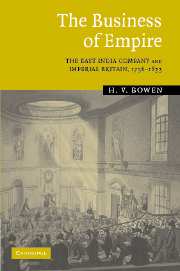Book contents
- Frontmatter
- Contents
- List of figures
- List of tables
- Preface
- Notes on the text
- List of abbreviations and short titles
- 1 Introduction
- 2 Relationships: city, state, and empire
- 3 Relationships: government and the Company
- 4 People: investors in empire
- 5 People: Company men
- 6 Methods: an empire in writing
- 7 Methods: the government of empire
- 8 Methods: the management of trade
- 9 Influences: the Company and the British economy
- Afterword
- Index
4 - People: investors in empire
Published online by Cambridge University Press: 09 July 2009
- Frontmatter
- Contents
- List of figures
- List of tables
- Preface
- Notes on the text
- List of abbreviations and short titles
- 1 Introduction
- 2 Relationships: city, state, and empire
- 3 Relationships: government and the Company
- 4 People: investors in empire
- 5 People: Company men
- 6 Methods: an empire in writing
- 7 Methods: the government of empire
- 8 Methods: the management of trade
- 9 Influences: the Company and the British economy
- Afterword
- Index
Summary
The financial speculation and political infighting at the heart of the deep internal crisis that shook the East India Company during the 1760s ensured that the collective characteristics of the several thousand proprietors who ‘owned’ the Company changed dramatically in a very short space of time. Further alterations then followed as late eighteenth-century additions were made to the Company's joint-stock capital and greater numbers of Britons began to invest in stocks and shares. As a result, the geographical, social, and structural profiles of the East India stockholding community of the 1830s were very different from those that had been evident seventy years earlier. Analysing these changes is a matter of some importance in order to establish the collective identity of the men and women who constituted the East India Company in Britain. The stockholders derived financial reward from the Company's overseas activities and, although they were far removed from active involvement in the process of overseas expansion, they participated in the decision-making processes that shaped the political development of East Indian affairs in London. Accordingly, this chapter seeks to examine the Company's stockholders with a view to establishing who they were, why they held stock, how they acted, and how their group composition altered over time.
PROFIT, POWER, AND PUBLIC SERVICE
No restrictions were placed upon the purchase of East India stock, and consequently the General Court was often represented as a popular assembly in which the rich and powerful rubbed shoulders with small investors.
- Type
- Chapter
- Information
- The Business of EmpireThe East India Company and Imperial Britain, 1756–1833, pp. 84 - 117Publisher: Cambridge University PressPrint publication year: 2005

